Marilá Dardot
ARTIST
MARILÁ DARDOT (BELO HORIZONTE, BRASIL, b. 1973)
ESCULTURA, INSTALACIÓN, OBJETO
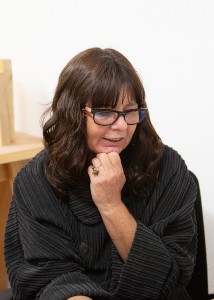
DICIEMBRE, 2021
Antes que ser artista, soy lectora
Entrevista con Marilá Dardot
Por Regina De Con Cossío
Fotografías por Fernanda Segura
La literatura, el lenguaje y la escritura son parte fundamental del trabajo de Marilá Dardot. Las propiedades que cada uno le ofrecen son la oportunidad ideal para transitar de lo escrito a lo visual y hacer de ambos una enunciación sobre las formas de ver el mundo. En esta conversación, Marilá comparte aspectos claves de su práctica y ahonda en las implicaciones éticas, formales y estéticas de trabajar con la palabra escrita y visual.
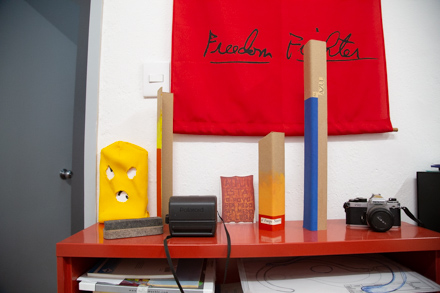
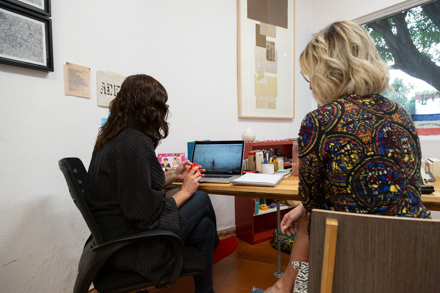
Regina de Con Cossío: Naciste en Brasil, pero has pasado algún tiempo en Portugal y, ahora, en México. ¿Crees que el territorio geográfico influye en tu quehacer artístico? ¿Cómo funciona ese proceso?
Marilá Dardot: El sentimiento de ser extranjera me acompaña desde muy pequeña. En Brasil, nací en Belo Horizonte, crecí en Olinda, regresé a Belo Horizonte, viví en Río de Janeiro y en São Paulo. En 2016 me mudé a Lisboa y desde el año pasado vivo en la Ciudad de México. Cada una de estas ciudades se presenta como un universo distinto que tuve que explorar: probar sus caminos, comprender el trazado de las calles, las sutilezas del lenguaje, tender puentes, redes de afecto, establecer intercambios. Tuve que empezar una y otra vez. Entonces creo que, más que el territorio en sí, vivir en un flujo de cambio es lo que influye en mi proceso. Sentir no pertenencia y fugacidad en tu piel plantea muchas preguntas existenciales que acaban apareciendo en el trabajo.
RCC: Tu exposición más reciente en El Eco, titulada Primera Plana, es una intervención directa en el espacio público: el anuncio de la exposición es una pieza en sí misma que dialoga con espectadores que podrían no ir a un museo. ¿Cómo concibes a los espectadores en este tipo de intervenciones? ¿Hay una investigación detrás de ellos, los distingues de aquellos que van al museo?
MD: En octubre de 2020, Inhotim me invitó a inaugurar el proyecto de 15 segundos, que consistía en intervenir diariamente en espacios publicitarios en la ciudad de Belo Horizonte durante un mes. Aquí en la Ciudad de México, Primera Plana fue presentada por el Museo Experimental el Eco durante mayo de 2021, con inserciones en pantallas publicitarias en las estaciones de metrobus. Dado que los museos permanecían cerrados debido a la pandemia, el proyecto parte inicialmente de una necesidad institucional de llegar a las personas que no pudieron visitar sus espacios.
A la hora de crear una obra específicamente para ocupar un espacio público, pienso en estrategias para que pueda ser percibida como algo que provoca extrañeza, pero a la vez logre ser leída por un espectador no formado en la sintaxis del arte contemporáneo, que lo haga reflexionar sin necesidad de saber que es una obra de arte. Así, al exhibirse directamente en las calles, llegando potencialmente a cualquiera que transite por la ciudad, la obra de arte en sí se expande, cada capa extra de realidad la modifica.
La inserción de una obra en este circuito también critica los propios medios de persuasión en los que se infiltra (hay aquí una referencia a la obra Inserción en circuitos ideológicos, que Cildo Meireles realizó entre 1970 y 1975, durante la dictadura en Brasil: una serie de obras que imprimieron frases consideradas subversivas en billetes y botellas de oca-Coca-Cola. Cildo sacó de circulación los artículos, se entrometió y los devolvió al mercado).
RCC: En ese mismo sentido, hay una intervención de lo político muy fuerte en este tipo de obras. ¿Qué función tiene lo político en tu proceso artístico?
MD: No diría que lo político tiene una función, sino que atraviesa cualquier proceso artístico. Como artista, creo que todo lo que produzco es político en alguna instancia, quizás en mis producciones más recientes esto aparece de una manera más explícita e intencional. Estoy en el mundo y me afecta lo que sucede, e incluso si una obra no parece política a primera vista, después de un tiempo ves el reflejo de un contexto político más amplio allí.
En tus últimas exploraciones artísticas hay un vínculo muy estrecho con el periodismo. El periodismo es un quehacer diario que, debido a las redes sociales y a la frecuencia actual de información, prácticamente no descansa. ¿Qué criterios usas para seleccionar la información del periodismo que te será útil para tus piezas artísticas?
MD: La escritura periodística apareció por primera vez en mi trabajo en 2015, cuando fui a hacer una residencia en Casa Wabi. Estaba lejos de mi biblioteca. Un gran muro de hormigón gris separaba la casa del mundo exterior. Había una demanda para hacer una bitácora. El primer día que me desperté, un mensaje de un grupo de amigas me alertó de algo que había sucedido en París, así que fui a ver las noticias. Todos estos elementos (la falta de mi biblioteca, el muro, la bitácora, la noticia) me llevaron a crear la pieza Diário. A partir de ahí, mis fuentes, en su mayoría literarias, se fueron ampliando y muchas obras se basan en textos periodísticos. Podría decir que los criterios para utilizarlos son el uso de diferentes vehículos impresos y el intento de aportar un pensamiento crítico a partir de un tema en particular, como investigar qué sujetos colectivos que actúan en una sociedad están legitimados por la prensa, en el caso de Primera Plana.
RCC: En este mismo sentido, ¿qué papel juega la ética y la moral en tu proceso artístico? Sabemos que el periodismo no siempre actúa éticamente (tergiversa la información y obedece a poderes económicos o políticos). ¿Cómo lidias con eso?
MD:
Enquanto os homens exercem
Seus podres poderes
Morrer e matar de fome
De raiva e de sede
São tantas vezes
Gestos naturais
Eu quero aproximar o meu cantar vagabundo
Daqueles que velam pela alegria do mundo
Indo e mais fundo
Tins e bens e tais
Caetano Veloso, Podres poderes
Entiendo y practico la ética a través de Spinoza, es decir, no como obediencia a una moral imperante, basada en valores ajenos al sujeto para que él pueda alcanzarlos, adaptando su realidad a aquellos, sino partiendo precisamente de la realidad humana en sus aspectos negativos, sin refutarlo –los afectos negativos– para transformarlos en afectos positivos, a través del deseo, el conocimiento y la libertad. Entonces, a menudo empiezo por lo que me afecta negativamente –los “poderes podridos” que canta Caetano, o sus traducciones en las noticias– para crear algo que afecte positivamente al otro, para ejercer su potencia y alegría.
RCC: Me llama mucho la atención que una buena parte de tu trabajo esté relacionado con los libros, en específico la literatura. Y, ahora, con el periodismo. ¿Qué similitudes encuentras entre el periodismo y la literatura y qué diferencias desde el aspecto artísticos?
MD: Antes de ser artista, soy lectora. Pensemos en el lenguaje como una gran paleta de colores con la que compongo mi obra: la literatura me ofrece muchos colores e infinitas combinaciones, entre ellos, es una escritura más libre y llena de sutilezas. El periodismo se acerca más a una paleta de blancos, negros y grises: hay menos posibilidades, las estructuras y los personajes son más limitados. Pero ninguno de ellos es neutral, en cualquier texto literario o periodístico se revela cierto punto de vista sobre el mundo. Mi trabajo es un intento de materializar posibilidades de otros puntos de vista a partir de todo lo que leo, sin distinguir la ficción de lo que se dice realidad.
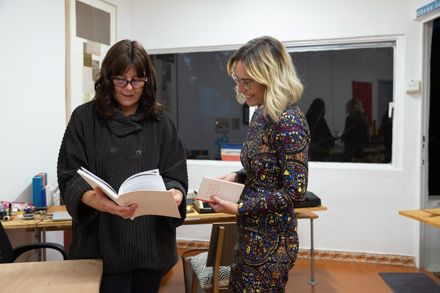
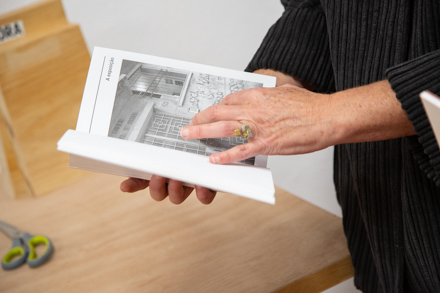
Before being an artist, I am a reader
Interview with Marilá Dardot
By Regina De Con Cossío
PHOTOGRAPHS by Fernanda Segura
Literature, language and writing are a fundamental part of Marilá Dardot’s work. The properties that each one offers are the ideal opportunity to move from the written to the visual and make out of both an enunciation about the ways of seeing the world. In this conversation, Marilá shares key aspects of her practice and delves into the ethical, formal, and aesthetic implications of working with the written and visual word.
Regina de Con Cossío: You were born in Brazil, but you have spent some time in Portugal and, now, in Mexico. Do you think that the geographical territory influences your artistic work? If so, how does it work?
Marilá Dardot: The feeling of being a foreigner has been with me since I was a kid. In Brazil, I was born in Belo Horizonte but grew up in Olinda, then I returned to Belo Horizonte, and I have lived in Rio de Janeiro and São Paulo. In 2016 I moved to Lisbon and since last year I have lived in Mexico City. Each of these cities is presented as a different universe that I had to explore: experience their paths, understand the layout of the streets, the subtleties of language, build bridges, networks of affection, establish exchanges. I had to start over and over again. So I think that, more than the territory itself, living in a flux of change is what influences my process. Feeling not belonging and fleeting in your own skin raises many existential questions that end up appearing at work.
RCC: Your most recent exhibition at El Eco, titled Primera Plana, is a direct intervention in the public space: the announcement of the exhibition is a piece in itself that dialogues with viewers who might not go to a museum. How do you conceive the spectators in this type of intervention? Is there an investigation behind them, do you distinguish them from those who go and visit museums?
MD: In October 2020, Inhotim invited me to inaugurate the 15 seconds project, which consisted of a daily intervention in advertising spaces in the city of Belo Horizonte for a month. Here in Mexico City, Primera Plana was presented by the Museo Experimental el Eco during May 2021, with interventions to the screens of different metrobus stations. Given that the museums remained closed due to the pandemic, the project was initially based on an institutional need to reach people who were unable to visit their spaces.
When creating a work specifically to occupy a public space, I think of strategies so that it can be perceived as something that provokes strangeness, but at the same time manages to be read by a viewer not trained in the syntax of contemporary art, that makes them reflect without needing to know that it is a work of art. Thus, by being displayed directly on the streets, potentially reaching anyone who passes through the city, the work of art itself expands, each extra layer of reality modifies it.
The insertion of a work in this circuit also criticizes the very means of persuasion in which it infiltrates (here is a reference to the work Insertion in ideological circuits, which Cildo Meireles produced between 1970 and 1975 during the dictatorship in Brazil: a series of works that consisted of the printing of phrases, considered subversive, on bills and Coca-Cola bottles. Cildo took the articles out of circulation, intervened and returned them to the market).
RCC: In the same sense, there is a very strong political influence in this type of work. What function does politics have in your artistic process?
MD: I wouldn’t say that politics has a function, but that it goes through any artistic process. As an artist, I believe that everything I produce is political in some instances, perhaps in my most recent works this appears in a more explicit and intentional way. I’m in the world and I’m affected by what happens, and even if a work doesn’t seem political at first glance, after a while you see the reflection of a larger political context there.
RCC: In your latest artistic explorations there is a very close link with journalism. Journalism is a daily task that, due to social networks and the current flow of information, does not rest. What criteria do you use to select the information that will be useful for your artistic pieces?
MD: Journalistic writing first appeared in my work in 2015, when I went to do a residency at Casa Wabi. I was far from my personal library. A large gray concrete wall separated the house from the outside world. There was an obligation to do a log. The first day I woke up and a message from a group of friends alerted me of something that had happened in Paris, so I went to watch the news. All these elements (the lack of my library, the wall, the blog, the news) led me to create Diário. From then on, my sources, mostly literary, were expanded and many artworks are based on journalistic texts. I could say that the criteria for using them are the use of different printed vehicles and the attempt to contribute to thee critical thinking based on a particular topic, such as investigating which collective subjects that act in a society are legitimized by the press, in the case of Front Page.
RCC: In this same sense, what role do ethics and morals play in your artistic process? We know that journalism does not always act ethically (it distorts information and obeys economic or political powers). How do you deal with that?
MD:
Enquanto os homens exercem
Seus podres poderes
Morrer e matar de fome
De raiva e de sede
São tantas vezes
Gestos naturais
Eu quero aproximar o meu cantar vagabundo
Daqueles que velam pela alegria do mundo
Indo e mais fundo
Tins e bens e tais
Caetano Veloso, Podres poderes
I understand and practice ethics through Spinoza, this means not as obedience to a prevailing morality, based on values far to the subject so that they can achieve them, adapting their reality to those, but starting precisely from human reality in its negative aspects, without refuting it –the negative effects– to transform them into positive effects, through desire, knowledge and freedom. So, I often start with what affects me negatively – the “rotten powers” that Caetano sings about, or their translations in the news – to create something that positively affects the other, to exert their power and joy.
RCC: It came to my attention that a large part of your work is related to books, specifically literature, and now with journalism. What similarities and differences do you find between journalism and literature from the artistic point of view?
MD: Before being an artist, I am a reader. Let’s think of language as a great palette of colors with which I compose my work: literature offers me many colors and infinite combinations among them, it is a freer writing full of subtleties. Journalism is closer to a palette of black, white and gray: there are fewer possibilities, the structures and characters are more limited. But none of them is neutral, in any literary or journalistic text a certain point of view about the world is revealed. My work is an attempt to materialize the possibilities of other points of view from everything I read, without distinction between fiction and reality.


